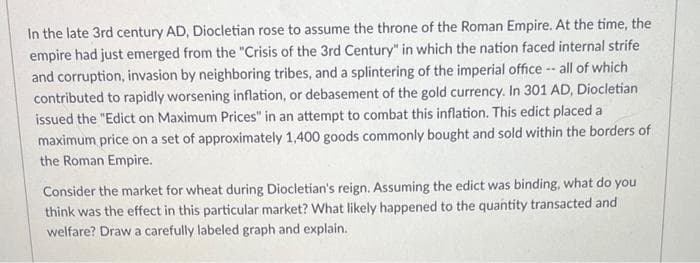In the late 3rd century AD, Diocletian rose to assume the throne of the Roman Empire. At the time, the empire had just emerged from the "Crisis of the 3rd Century" in which the nation faced internal strife and corruption, invasion by neighboring tribes, and a splintering of the imperial office -- all of which contributed to rapidly worsening inflation, or debasement of the gold currency. In 301 AD, Diocletian issued the "Edict on Maximum Prices" in an attempt to combat this inflation. This edict placed a maximum price on a set of approximately 1,400 goods commonly bought and sold within the borders of the Roman Empire. Consider the market for wheat during Diocletian's reign. Assuming the edict was binding, what do you think was the effect in this particular market? What likely happened to the quantity transacted and welfare? Draw a carefully labeled graph and explain.
In the late 3rd century AD, Diocletian rose to assume the throne of the Roman Empire. At the time, the empire had just emerged from the "Crisis of the 3rd Century" in which the nation faced internal strife and corruption, invasion by neighboring tribes, and a splintering of the imperial office -- all of which contributed to rapidly worsening inflation, or debasement of the gold currency. In 301 AD, Diocletian issued the "Edict on Maximum Prices" in an attempt to combat this inflation. This edict placed a maximum price on a set of approximately 1,400 goods commonly bought and sold within the borders of the Roman Empire. Consider the market for wheat during Diocletian's reign. Assuming the edict was binding, what do you think was the effect in this particular market? What likely happened to the quantity transacted and welfare? Draw a carefully labeled graph and explain.
Principles of Economics 2e
2nd Edition
ISBN:9781947172364
Author:Steven A. Greenlaw; David Shapiro
Publisher:Steven A. Greenlaw; David Shapiro
Chapter19: The Macroeconomic Perspective
Section: Chapter Questions
Problem 29P: The prime interest rate is the rate that banks charge their best customers. Based on the nominal...
Related questions
Question
A5

Transcribed Image Text:In the late 3rd century AD, Diocletian rose to assume the throne of the Roman Empire. At the time, the
empire had just emerged from the "Crisis of the 3rd Century" in which the nation faced internal strife
and corruption, invasion by neighboring tribes, and a splintering of the imperial office -- all of which
contributed to rapidly worsening inflation, or debasement of the gold currency. In 301 AD, Diocletian
issued the "Edict on Maximum Prices" in an attempt to combat this inflation. This edict placed a
maximum price on a set of approximately 1,400 goods commonly bought and sold within the borders of
the Roman Empire.
Consider the market for wheat during Diocletian's reign. Assuming the edict was binding, what do you
think was the effect in this particular market? What likely happened to the quantity transacted and
welfare? Draw a carefully labeled graph and explain.
Expert Solution
This question has been solved!
Explore an expertly crafted, step-by-step solution for a thorough understanding of key concepts.
Step by step
Solved in 3 steps with 1 images

Knowledge Booster
Learn more about
Need a deep-dive on the concept behind this application? Look no further. Learn more about this topic, economics and related others by exploring similar questions and additional content below.Recommended textbooks for you

Principles of Economics 2e
Economics
ISBN:
9781947172364
Author:
Steven A. Greenlaw; David Shapiro
Publisher:
OpenStax


Exploring Economics
Economics
ISBN:
9781544336329
Author:
Robert L. Sexton
Publisher:
SAGE Publications, Inc

Principles of Economics 2e
Economics
ISBN:
9781947172364
Author:
Steven A. Greenlaw; David Shapiro
Publisher:
OpenStax


Exploring Economics
Economics
ISBN:
9781544336329
Author:
Robert L. Sexton
Publisher:
SAGE Publications, Inc